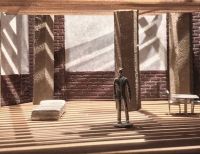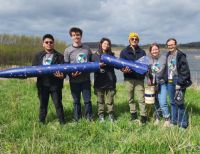An unmistakable takeaway from sessions of “UnrulyArt” is that all those “-n’ts” — can’t, needn’t, shouldn’t, won’t — which can lead people to exclude children with disabilities or cognitive, social, and behavioral impairments from creative activities, aren’t really rules. They are merely assumptions and stigmas.
When a session ends and the paint that was once flying is now just drying, the rewards that emerge are more than the individual works the children and their volunteer helpers created. There is also the joy and the intellectual engagement that maybe was experienced differently but nevertheless could be shared equally between the children and the volunteers.
When MIT professor Pawan Sinha first launched UnrulyArt in 2012, his motivation was to share the joy and fulfillment he personally found in art with children in India who had just gained their sense of sight through a program he founded called Project Prakash.
“I felt that this is an activity that may also be fun for children who have not had an opportunity to engage in art,” says Sinha, professor of vision and computational neuroscience in the Department of Brain and Cognitive Sciences (BCS). “Children with disabilities are especially deprived in this context. Societal attitudes toward art can keep it away from children who suffer from different kinds of cognitive, sensory, or motoric challenges.”
Margaret Kjelgaard, an assistant professor at Bridgewater State University and Sinha’s longtime colleague in autism research and in convening UnrulyArt sessions, says that the point of the art is the experience of creation, not demonstrations of skill.
“It’s not about fine art and being precise,” says Kjelgaard, whose autistic son had a blast participating in his own UnrulyArt session a decade ago and still enjoys art. “It’s about just creating beautiful things without constraint.”
UnrulyArt’s ability to edify both children with developmental disabilities and the scientists who study their conditions interleaves closely with the mission of the Simons Center for the Social Brain (SCSB), says Director Mriganka Sur. That’s why SCSB sponsored and helped to staff four sessions of UnrulyArt recently in Belmont and Burlington, Massachusetts.
“As an academic research center, SCSB activities focus mainly on science and scientists,” says Sur, the Newton Professor in BCS and The Picower Institute for Learning and Memory at MIT. “Our team thought this would be a wonderful opportunity for us to do something outside the box.”
Getting unruly
At a session in a small event hall in Burlington, SCSB postdocs and administrators and members of Sinha’s lab laid down tarps and set up stations of materials for dozens of elementary school children from the LABBB Educational Collaborative, which provides special education services to schoolchildren from ages 3 through 22 from local communities. In all, UnrulyArt hosted approximately 60 children across four sessions earlier this spring, says program director Donna Goodell.















